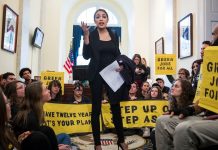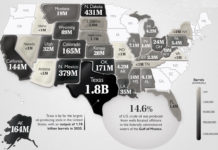
Fighting for Our Future
Fee and Dividend Is Where Hope Is:
Biden Can Do This Without Congress’s Approval
—TABLE OF CONTENTS FOR THIS PAGE—
- Fighting for Our Future Campaign
- Op-Ed by Dr. Hansen: “Biden should impose a carbon fee immediately”
Who is Dr. James Hansen?
Dr. James Hansen was the director of NASA’s Goddard Institute for Space Studies for over 30 years. Along with an all-star group of scientists, he took on the IPCC (Intergovernmental Panel on Climate Change) consensus that 450ppm of CO2–and two degrees centigrade of temperature rise over pre-industrial levels were safe, and completely changed the discussion. He was the first scientist to sound the alarm on Climate Change at a 1988 congressional hearing. He would later initiate a groundbreaking climate lawsuit on behalf of children.
Fighting for Our Future: A Campaign to Jumpstart Climate Action Using Fee-and-Dividend
Dr. James Hansen has put forward a proposal that offers real hope and a way around the roadblock on significant climate action in the Senate. His plan utilizes the Independent Offices Appropriations Act, which authorizes President Biden to direct the E.P.A. to put in place a carbon-fee-and-dividend structure.
In a recent Boston Globe op-ed, Dr. Hansen laid out the basic framework, which includes safeguards to ensure that all but the top 30% of income-earners would receive more in dividends than they pay in fees, thus negating a frequent criticism of carbon tax proposals as regressive.
But there are other concerns which have been raised, both in scientific and community circles, which the staff of the Texas Drought Project thoroughly reviewed. They’re briefly outlined here, together with how they can be addressed alongside a carbon fee. Also covered herein—the reasons why this could be the only opportunity we have at present to mitigate climate change.
One of the most fervent, long-term advocates for a carbon-fee proposal is Bill McKibben of 350.org. He warns that it has to conform to the framework below or it will fail to achieve its goals.
- There can be no offsets or selling of credits, and no carbon trading.
- Toxic energy production—waste incineration, biomass, nuclear, even coal— cannot be considered part of the solution, as there is a long history of harming the low-income and minority communities in which they are frequently located.
- The carbon tax rate has to be raised on a regular basis. British Columbia saw emissions fall 19% in the years after the fee was first imposed, but the government failed to increase the rate, and eventually, emissions started rising again.
- It cannot be the ONLY thing that is done. It has to be a part of major regulatory change across sectors like the military, transportation, agriculture and waste. And it must be imposed on equivalent emitting industry, which would mean a tax on methane and nitrous oxide.
Many scientists and engineers alike also favor the proposal, but they too advise that a carbon fee can’t be the only solution. Carbon in the atmosphere has reached 419 ppm, and in order to mitigate climate change, carbon dioxide removal or sequestration has to be a major component. This would include agricultural and forestry practices that sequester carbon as well as direct-air capture.
Other experts have weighed in, calling for a “border tax/fee.” When products arrive at our border, they would have to pay a tax or fee at the same rate as emitting industry in our own country, or the nation exporting to ours would have to implement their own equivalent carbon-fee system. This would have a substantial effect on emissions if China were to sign on, and it would incentivize carbon-fee systems throughout the world.
Many social justice advocates have warned that there would be other consequences. Many Americans live in food deserts, and with Agriculture being included as a sector subject to the fee, would some no longer have access to enough food to feed their families? Clearly, changes must be made to Big Ag and family farms must be incentivized.
There are challenges to the implementation of such a fee, no doubt, but the challenges we face in getting the Green New Deal, or any other substantive legislation through our present Congress, are mounting daily. The Minority Leader of the Senate has stated his opposition to the Biden agenda as a whole, and vowed to defeat any part of it. The Heritage Foundation and Charles Koch have funneled massive donations to Democratic senators Manchin and Sinema, who are blocking the removal of the filibuster, a barrier that Democrats cannot overcome without their votes. And although Democrats could conceivably pass one more bill this year using reconciliation, with obstructionists like Manchin and Sinema opposing many of Biden’s proposals—and currently meeting with Republican senators to draft their own bills—there is little-to-no-hope that anything put forward to mitigate Climate Change has a chance in this Congress. And if political analysts are correct and 2022 sees majorities shift to the GOP in both houses, the situation will only get worse.
The Hansen proposal, with the kind of caveats laid out here, could be our only way forward. As we face the fact that we’re running out of time, it seems prudent to use every tool we have. And this could prove to be a very powerful tool.
Op-Ed by Dr. James Hansen
“Biden should impose a carbon fee immediately”
The Boston Globe: June 1, 2021
Under the Independent Offices Appropriations Act, the president retains authority to direct the Environmental Protection Agency to impose a fee on greenhouse gas emissions.
President Biden has inherited a welter of urgent challenges, which he and his team are confronting with alacrity and skilled professionalism. In this moment, he has an exceptional opportunity to address, as he so aptly put it, the “existential climate crisis.”
Prior presidents, even those who recognized the climate threat, did not exercise their full statutory authority to restrict greenhouse gas emissions that cause global warming. As the public experiences an increased frequency of extreme climate events, as young people worldwide cry out against the threat to their future, and as the United Nations approaches a major climate conference in November in Glasgow, Biden has the opportunity to lay the groundwork for a rapid phaseout of United States and global emissions.
Under the Independent Offices Appropriations Act, the president retains authority to direct a relevant federal agency (here, the Environmental Protection Agency) to impose a fee on GHG emissions. The fee can be collected efficiently from the about 200 oil, gas, and coal companies that produce, refine, and distribute fossil fuels in the United States.
This is a crucial clarification to executive authority, because EPA has labored for decades under a presumption that it lacked authority to impose such fees. That assumption derived in part from an aside in a legal memorandum by then-EPA General Counsel E. Donald Elliott. Elliott had reviewed economic incentives available to the agency to restrict pollution but, by his own later admission, Elliott at that time was “woefully ignorant of the IOAA and related jurisprudence.” Writing in 2019, Elliott sought to “set the record straight that EPA does have existing authority to impose a reasonable user fee on releases of carbon dioxide and other GHGs . . . any time that it has the political will to do so.”
All nations are committed under the United Nations Framework Convention on Climate Change to stabilize GHG concentrations at a level that prevents “dangerous anthropogenic interference with the climate system.” However, UN efforts to limit emissions with voluntary goals, including the 1997 Kyoto Protocol and 2015 Paris Agreement, simply have not sufficed. The principal GHG — carbon dioxide — will continue to increase rapidly as long as the price of fossil fuels does not even begin to include their ultimate costs to society.
Economists agree that a rising carbon price covering all fossil fuel uses is essential for rapid phasedown of emissions. More than 3,500 economists — including 28 Nobel Prize laureates, all four living former chairs of the Federal Reserve, and 15 former chairs of the President’s Council of Economic Advisers — issued a statement endorsing a carbon fee and dividend. More than 400 student body presidents, representing more than 4 million college students across all 50 states, support a carbon fee and dividend as well.
The collected fee could be returned equally to all adult legal residents of the nation, with a half-share for each child, up to two children per family. People without a bank account would receive a debit card. Seventy percent of the public would receive more in their carbon dividend than they pay in increased prices. True, wealthy people tend to have a larger carbon footprint and would lose money, but they can afford it. Fee and dividend thus will help address wealth disparity.
Carbon fees and dividends support all other actions to phase down carbon emissions. They spur economically efficient energy investments, and provide essential economic guidance if we are to “build back better.”
The International Monetary Fund advises that the carbon price must rise to at least $75 per ton of CO2 emissions. That is a reasonable estimate, though the fee can be raised further if emission reduction targets are not timely achieved.
The United States is the nation most responsible for historic emissions and thus for global climate change, but China is most responsible for current emissions. Both nations have much to lose from growing climate change, and their cooperation is essential for success in stemming the threat of irreversible impacts such as devastating sea level rise. If China and the United States agree on meaningful carbon fees, they can readily make it near-global via border duties on products from countries without carbon fees; that would encourage most nations to adopt the policy, so as to retain such revenue for their own people. And that would help to further Biden’s goal of addressing the “existential climate crisis.”
James E. Hansen is director of Climate Science, Awareness and Solutions at the Earth Institute at Columbia University. Daniel M. Galpern is general counsel of Climate Protection and Restoration Initiative.
What We’re Doing, and How You Can Help
The Texas Drought Project has been busy since August of 2018 building a broad and diverse coalition in 12 targeted Texas congressional districts. We’ll call upon those groups and individuals as we publicize the importance of this bold action, recruiting others to our cause. Then we’ll organize phone banks all over the state, unleashing a robust social media, postcard, and letter-writing campaign to get tens of thousands to contact their representatives through every possible channel, with one ask—please call upon President Biden to take action now.
Take Action NOW!
- Call President Biden at the White House comment line with the same message at 202-456-1111
- Contact us to get involved in the Fighting for the Future Campaign
- Support us financially by clicking the button below!
Texas Drought Project and Texas Harambe Foundation do not engage, participate, or intervene in political campaign activity, and do not endorse or oppose any candidate for office.





